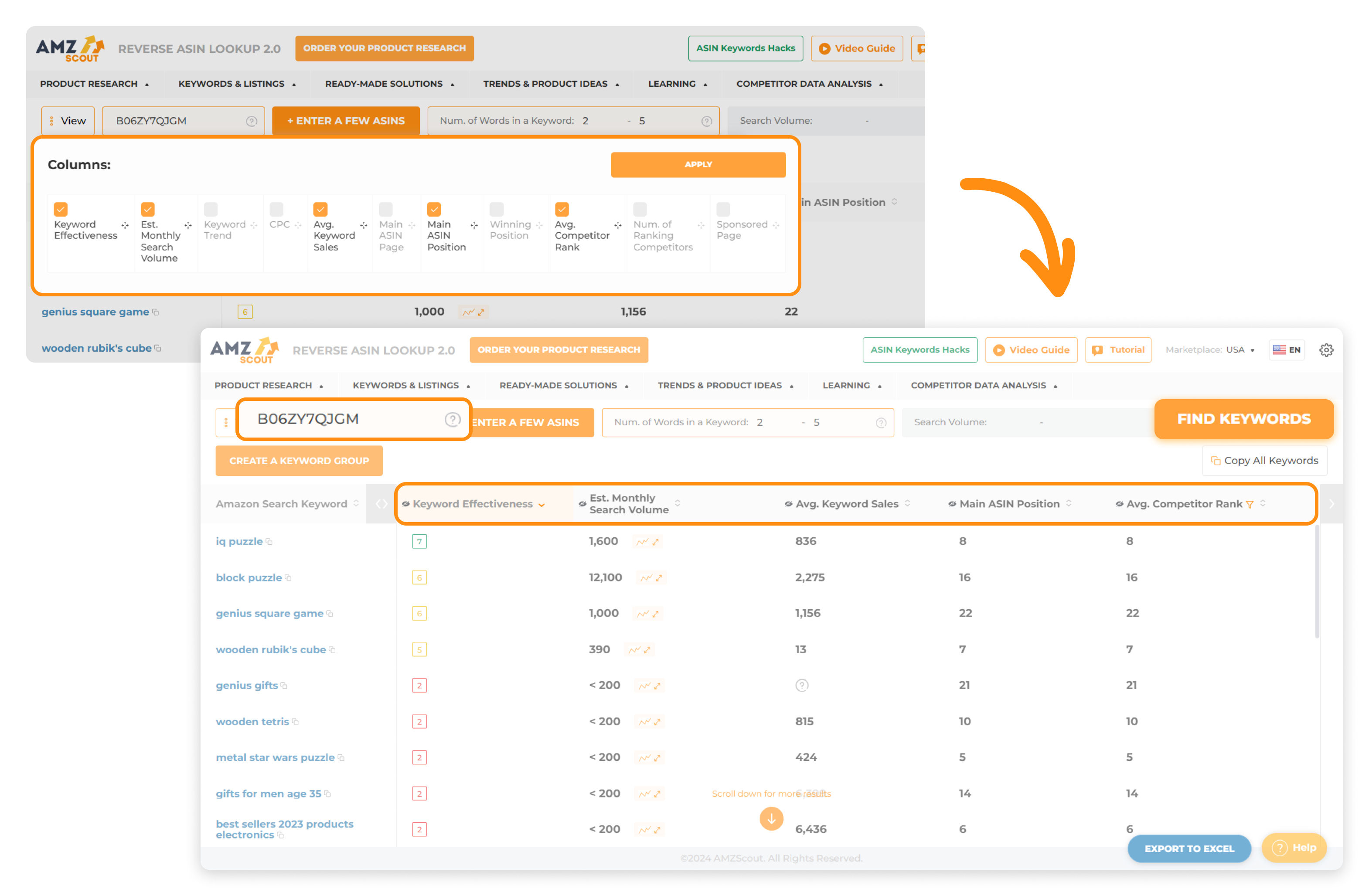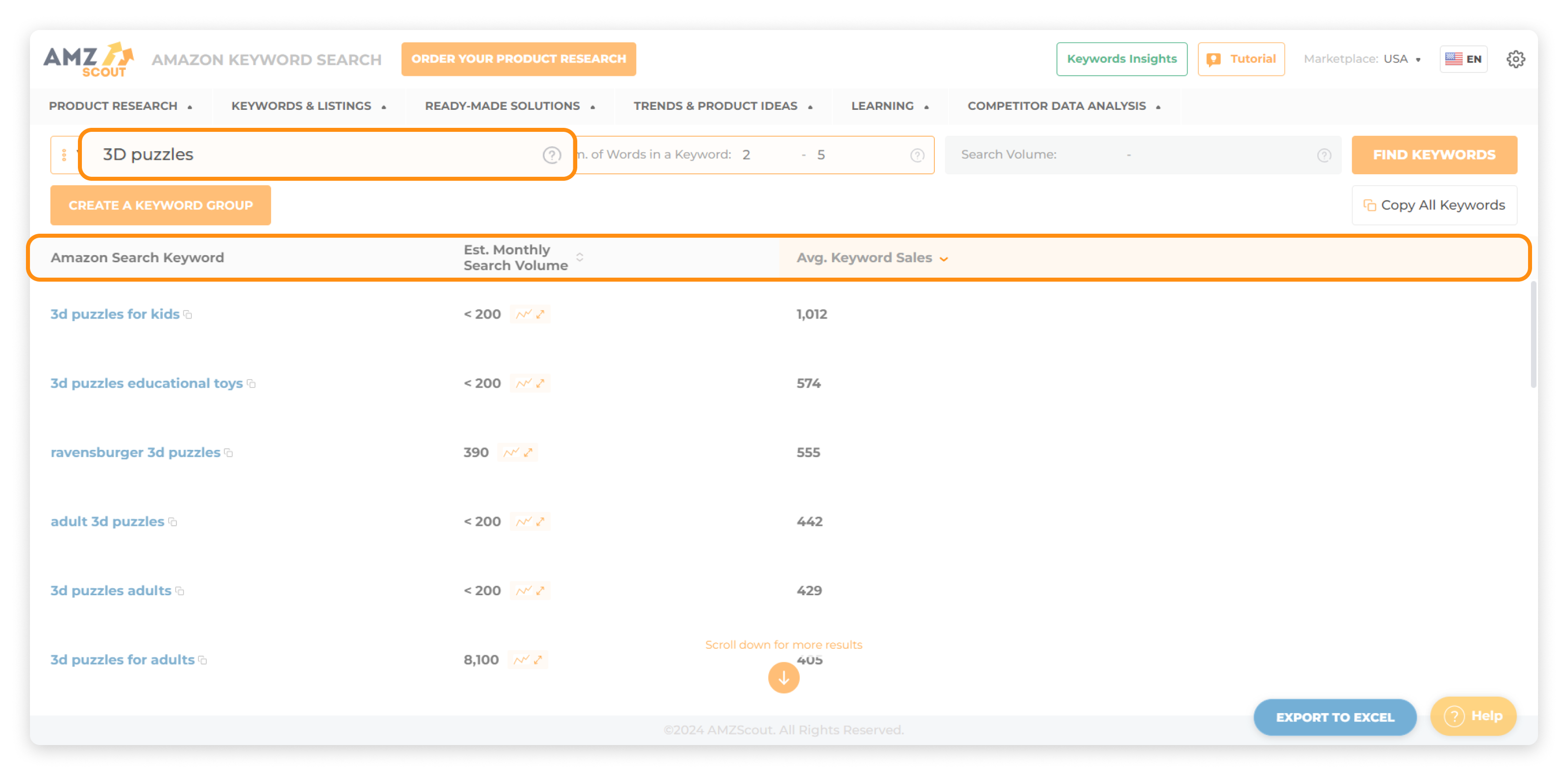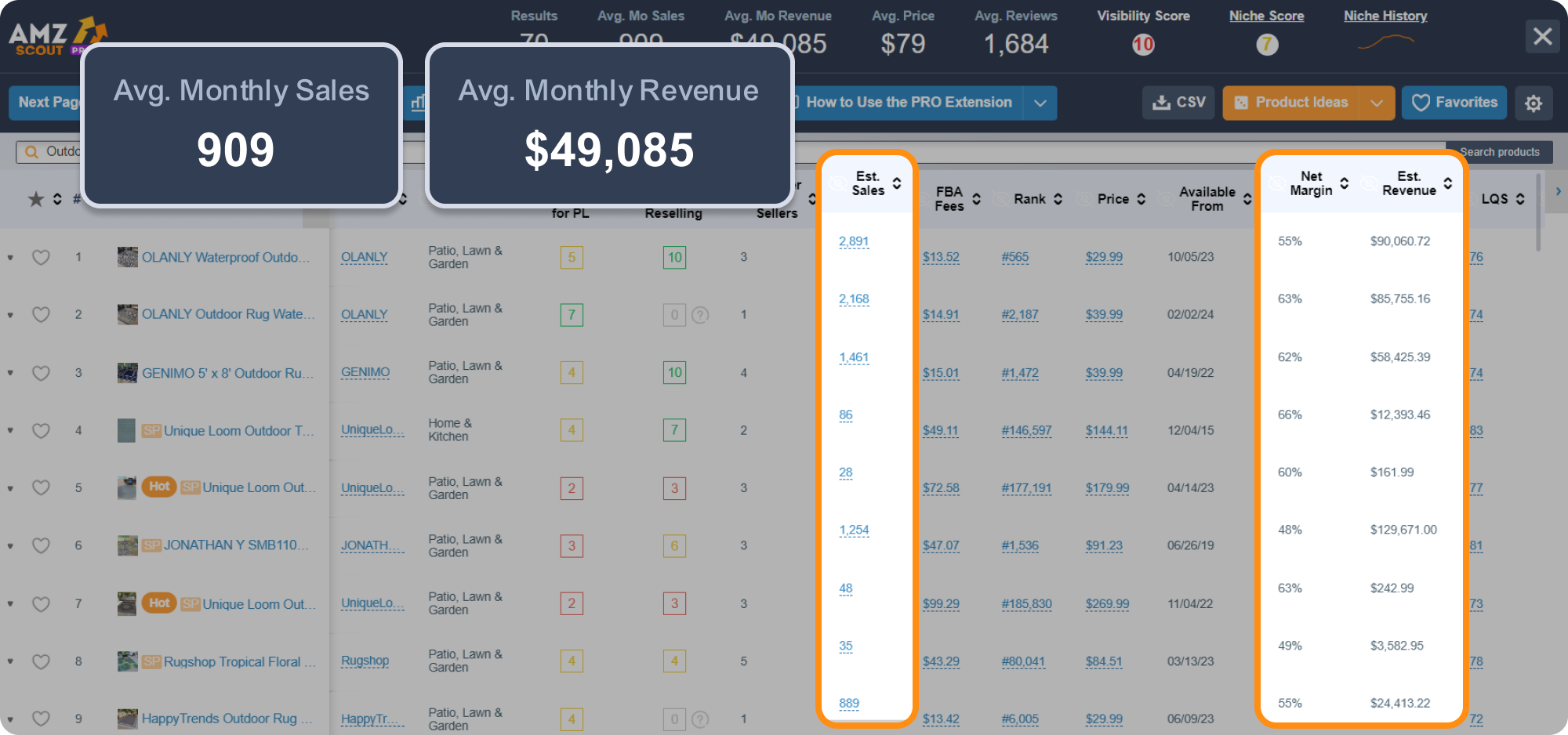
Effective Use of Amazon Competitors’ Keywords for Higher Rankings
In order to succeed on Amazon, it’s essential to understand the market. Keywords are a pivotal component of this process, as they help you spot trends and identify your competitors. In 2025, with Amazon’s powerful A10 algorithm, choosing the right keywords matters more than ever. By analyzing the keywords your competitors use, you can conduct effective competitor analysis to gain valuable insights into their strategies, refine your approach, and enhance product performance.
This article will guide you through the process of pinpointing your Amazon competitors and outline the steps to finding the keywords they use.
Table of contents
- Step 1: Identify Your Competitors
- Step 2: Get Your Amazon Competitors’ Keywords
- Step 3: Analyze Your Competitors’ Keywords to Find the Most Effective Ones
- Step 4: Use Competitors’ Keywords to Improve Your Performance
- Amazon Keyword Research Methods Comparison
- How to Find Your Competitors
- Pitfalls to Avoid When Leveraging Competitors’ Keywords
- FAQs
Step 1: Identify Your Competitors
First of all, it’s essential to determine which competitors you should focus on studying. In this article, we recommend targeting those who sell similar products to yours, and have strong rankings or impressive sales figures. By analyzing these competitors, you can extract the keywords they’re using successfully, analyze their best practices, and locate gaps in the market.
If you’re unsure how to identify key competitors, don’t worry—we’ve included a detailed guide below to walk you through the process, step-by-step. Now let's discuss how to find competitor keywords on Amazon.
Step 2: Get Your Amazon Competitors’ Keywords
To see which keywords your competitors use, start by analyzing their Amazon listings. By noting frequently-used terms, you’ll gain a greater understanding of their keyword strategy. To streamline this process, consider using specialized tools.
Way 1: Analyze Reviews with the AI Review Analyzer
Customer reviews offer a goldmine of keywords that real buyers use to describe a product. These insights can help you understand which features resonate most with customers and the kind of language they naturally use.
However, manually analyzing dozens or even hundreds of reviews to spot patterns can be time-consuming. That’s where AMZScout’s AI Review Analyzer comes in.
How to use it:
1. Go to the AI Review Analyzer. Enter your email address to start a free trial (which includes one free product check).
2. Enter the ASIN. Click “Analyze Product by ASIN”, input the product’s ASIN, and click “Get Review Analysis”.
3. Review the results. The tool will generate statistics, graphs, and text-based insights based on customer reviews. The text explanation is based on customer phrases, which you can then use as keywords.
While this method helps you identify visible keywords, it doesn’t provide insights into statistics on the keywords’ efficiency or backend keywords (terms competitors use that are hidden from customers but influence search rankings). That’s why it’s helpful to combine this method with another tool for deeper keyword analysis.
Way 2: Extract Competitor Keywords Effortlessly and Check Their Performance
You can use the Reverse ASIN Lookup tool to perform competitor keyword research. By entering the ASINs of your competitors’ products, you will get a list of keywords that customers use to search for these products on Amazon.
Here’s how:
1. Go to the AMZScout Reverse ASIN Lookup.
2. Enter the ASIN(s) for the competitor's product. If you want to narrow down your search, you can specify the number of words or set a preferred search volume.
3. Get the keywords. Click "Find Keywords" to get the keywords and various statistics associated with them.
4. Analyze the results. For each keyword, the data is filtered by 10 parameters. Consider checking the following ones:
Keyword effectiveness: Shows how the keyword affects sales, its relevance to the product, and its trend.
Estimated monthly search volume: Indicates the number of searches for the keyword on Amazon.
Average keyword sales: Displays the average sales associated with that keyword.
Main ASIN position: Indicates on which Amazon page the product appears for that keyword.
You can also add additional filters, depending on your goals.
Then, choose the keywords with the strongest performance. Creating a list of these terms will help you optimize your product listings and enhance your PPC campaigns. Now, let’s explore how to pick the best keywords.
Step 3: Analyze Your Competitors’ Keywords to Find the Most Effective Ones
Once you've gathered a list of keywords from your competitors, the next step is to select the most relevant and high-performing ones. Not all keywords can be incorporated into your content without compromising readability, so you need to analyze and prioritize them based on several key parameters:
Search volume: High search volume indicates greater interest and potential traffic.
Competitiveness: Lower competition makes it easier to rank and stand out.
Relevance: Highly relevant keywords are more likely to drive conversions, while less effective ones can be used as backend keywords.
Seasonality: Understanding trends and seasonality can help you capitalize on peak demand.
CPC: Keywords with high CPC but low performance should be set as negative keywords in your ad campaigns to avoid wasted spending.
Monitoring all of these factors on your own can be time-consuming and challenging, especially for beginners. For those looking to achieve results quickly, Sellerhook offers a professional two-in-one service that includes both competitor analysis and keyword research.
Quick and Easy Competitor Keyword Analysis with Sellerhook
Sellerhook’s team of experts will conduct a personalized analysis tailored to your specific needs and objectives. All you need to do is answer a few brief questions, and you'll receive a comprehensive report that includes:
A complete list of keywords your competitors are using.
In-depth keyword analysis, highlighting the most and least relevant terms.
Competitor analysis based on first-page results for the most crucial keywords.
Detailed examination of top-selling products in your niche.
Insights into the latest best-selling products launched in 2025.
and more.
To learn more about this service and view a sample report, simply enter your email and have all the details sent to you. Sellerhook not only delivers valuable insights, but also provides actionable tips and strategies for optimizing your ads and product listings, ensuring you stay ahead of your competitors.
Step 4: Use Competitors’ Keywords to Improve Your Performance
Once you’ve identified the best keywords used by your competitors, you can use them to boost your own performance. Consider focusing on the following key aspects:
Create SEO-content: For optimized text, incorporate these keywords into your product title, description, and bullet points to increase visibility. Ensure that you adhere to Amazon's character limits while keeping your content engaging and informative.
Use backend keywords: Increase your product's visibility by adding relevant keywords in the backend. This allows you to target more search queries without cluttering your product page.
Launch effective ads: Enhance the relevance of your ads by using the most frequently searched keywords. This approach helps you attract more potential customers and improves your ad performance.
Adjust your ad budget: Track how your keywords are performing to find the optimal balance between search volume and CPC. This approach will help you allocate your budget more effectively and maximize your return on investment.
Add negative keywords: If you find that some of your competitors' keywords are irrelevant to your product or are driving clicks without resulting in purchases, add them to your list of negative keywords to avoid wasting your ad budget.
By monitoring your competitors' keywords consistently and applying them strategically, you can boost your own success. However, using keywords alone might not be enough to outsell your competition. Let’s explore some best practices employed by top Amazon sellers to stay ahead.
Amazon Keyword Research Methods Comparison
Reverse ASIN Lookup
Description: Analyzing competitors' listings to identify keywords they rank for.
Best For: Competitor keyword discovery
Pros: Provides direct insights into competitor strategies.
Cons: May not capture all keywords, especially backend ones.
Manual Listing Analysis
Description: Reviewing competitor product titles, bullet points, and descriptions.
Best For: Understanding keyword usage in context
Pros: Offers qualitative insights into keyword placement and relevance.
Cons: Time-consuming and may miss hidden keywords.
Amazon Autocomplete
Description: Using Amazon's search bar suggestions to find popular search terms.
Best For: Discovering trending and long-tail keywords
Pros: Quick and easy way to identify commonly searched terms.
Cons: Suggestions may be influenced by personal search history.
Keyword Research Tools
Description: Utilizing tools like AMZScout to find high-volume keywords.
Best For: Comprehensive keyword analysis
Pros: Provides data-driven insights with search volume and competition metrics.
Cons: May have a bit of a learning curve.
Competitor PPC Ads
Description: Analyzing keywords used in competitors' sponsored ads.
Best For: Identifying high-converting keywords
Pros: Reveals keywords that competitors are willing to pay for.
Cons: May not reflect organic keyword performance.
Backend Search Terms
Description: Reviewing and optimizing hidden keywords in Amazon Seller Central.
Best For: Enhancing listing discoverability
Pros: Improves listing visibility without affecting front-end content.
Cons: Keywords are not visible to customers; optimization can be complex.
Additional Tips to Outperform Your Competitors
If you want to stand out on Amazon, it’s crucial to optimize every aspect of your content strategically. Here are a few key tips for improving your overall performance:
Photos and videos: Use high-quality visual content with a clean, professional look that showcases your product from different angles. This helps to build customer confidence in their purchase decisions.
Prices: Stay updated on your competitors' prices and adjust yours accordingly. Strive to maintain a balance between competitiveness and profitability.
Ratings and reviews: Utilize the "Get a Review" button and participate in Amazon's Vine program to gather more reviews and build credibility. Positive reviews can significantly impact your sales.
A+ Content: Take advantage of Amazon’s A+ Content feature to create visually rich and informative product descriptions. Enhanced visuals help customers make more informed decisions, reducing return rates and fostering brand loyalty.
By applying these strategies consistently, you can elevate your listings and ads, making them truly stand out. This enhanced visibility will not only attract more attention but also lead to a significant boost in sales.
How to Find Your Competitors
If you're unsure how to identify your key seller competitors, here’s one of the most effective methods: start by exploring your own product’s category and subcategory. Then, use specific search terms and apply a price filter to compare items within a similar price range.
While this approach may seem straightforward, determining the right search terms and identifying top sellers can be challenging. To make this process clearer, let's delve into these aspects in more detail below.
Step 1: Conduct an Amazon Keyword Search
Keywords are the terms that potential customers use to search for products, and by targeting these same keywords, you can pinpoint the other sellers competing in your niche. To simplify your research and access detailed statistics on the most frequently-searched keywords, consider using AMZScout’s Keyword Search tool, which helps you generate a list of top-performing keywords quickly and make informed decisions.
Here's how:
1. Access the Keyword Search. Start a free trial by entering your email address—no credit card information is required.
2. Enter search criteria. Input a product-related phrase into the tool, such as “3D puzzles”. You can refine your search by specifying the number of keywords you want to retrieve and the desired search volume.
3. Retrieve your keywords. Click "Find Keywords" to generate a list of potential keywords. Review the results, paying close attention to the search volume and average monthly sales data on products for those keywords.
For instance, while "3D puzzle for adults" might be highly-searched, "wooden 3D puzzle games" might actually be the top seller.
4. Select relevant keywords. Once you've identified the top-performing keywords, narrow them down by relevance to your product. For example, if you specialize in wooden puzzles, you might want to exclude keywords related to metal puzzles.
After creating a focused list of relevant keywords, you're ready to move on to the next step: using these keywords to identify your key competitors.
Step 2: Pinpoint Your Key Competitors
Once you have a list of keywords, you can check each keyword manually in an Amazon search and filter products by:
Best Seller or Amazon’s Choice badge to spot top-performing products.
Newest Arrivals to see recently added items.
The first two pages of results to identify products that rank well.
However, this approach can be time-consuming, especially since bestseller lists and newest arrivals are updated hourly. For a more stable and reliable source of information, consider using the AMZScout PRO Extension. This tool not only helps you identify your main competitors, but also provides valuable insights into their performance.
Here’s how:
1. Install the AMZScout PRO AI Extension.
2. Search for a product on Amazon. Enter the keywords you want to target and view competitors for.
3. Open the PRO Extension. Click the icon in the upper right-hand corner of the page.
4. Filter the results. Select specific columns:
Estimated Sales, to view products with the highest sales for this keyword.
Available From, to see the most recently-added products for this keyword.
Rank, to find products with higher Amazon rankings.
5. Make a list. Consider compiling a list of up to 10 ASINs with the best performance for your relevant keywords.
Additionally, the extension provides valuable insights, such as pricing history, listing quality, and more. By studying this information, you can better understand your competitors’ strategies and adjust your own approach to stay ahead in the market.
Pitfalls to Avoid When Leveraging Competitors’ Keywords
Using competitors’ keywords can be incredibly insightful, but there are common mistakes that can undermine your strategy. Here are a few key pitfalls to watch out for:
1. Blindly Copying Keywords Simply copying a competitor’s keywords without analysis is a risky move. Not all keywords that work for them will perform well for your product. Differences in pricing, reviews, and product features can drastically affect how well a keyword converts for you.
2. Ignoring Search Intent Keywords may attract traffic, but if the search intent doesn’t match your product, you’ll get clicks without conversions. For example, a keyword targeting “budget-friendly” buyers won’t be effective if your product is premium-priced. Always align keywords with the intent of your target audience.
3. Overstuffing Keywords Stuffing your listings with competitor keywords in hopes of ranking higher can backfire. Amazon’s A10 algorithm favors relevance and conversion rates over sheer keyword volume. Overuse can make your listing look spammy and hurt your ranking.
4. Neglecting Long-Tail Keywords Focusing only on high-traffic keywords from competitors may make you miss valuable long-tail opportunities. These more specific phrases often have less competition and higher conversion potential, especially for niche products.
5. Failing to Monitor Performance Even carefully chosen competitor keywords need ongoing monitoring. Trends change, and keywords that perform well today may lose effectiveness tomorrow. Regularly tracking your listings’ performance ensures your strategy stays relevant.
Conclusion
Understanding your competitors' strategies is essential for effectively marketing your products. With tools like AMZScout, you can easily pinpoint your main competitors, while a professional analysis from Sellerhook provides deeper insights into their strategies. By leveraging this information, you can refine your approach, capture a larger market share, and drive overall business growth.
FAQs
How do I find Amazon competitors' keywords quickly?
The simplest way to find the keywords used by your Amazon competitors is by using AMZScout’s Reverse ASIN Lookup tool. Just enter the ASIN of a competitor's product, and you'll receive a comprehensive list of the keywords they target, along with important metrics like estimated search volume, average keyword sales, and more. This tool streamlines your research and provides valuable insights into your competitors' strategies.
Can you use competitors’ names as keywords?
It’s not recommended to use competitors' names as keywords, as this can be considered an intellectual property violation. Amazon prohibits ads from explicitly mentioning competitors by name, though phrases like “leading brand” are allowed. While ads can compare products without criticism, some countries completely ban using competitors' brand names at all.
What is Amazon competitor analysis?
Amazon competitor analysis involves evaluating sellers of similar products on Amazon by examining their product selection and selling strategies. This process helps to identify market opportunities and provides insights that enable you to enhance your own business approach, stand out, and increase sales. For a detailed guide on how to conduct a competitor analysis, click here.













